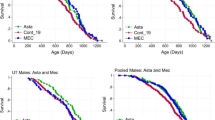Abstract
Dolichol (D) is a long-chain polyprenoid broadly distributed in the cell membranes, possibly endowed with a free-radical scavenging activity, whose concentration in tissues increases with increasing age. No enzyme pathway for D degradation has been discovered. In order to test the hypothesis that D might undergo a non-enzymatic free-radical mediated decomposition the effects of a xenobiotic agent (carbon tetrachloride, CCl4) and ultraviolet-B (UV-B) radiation on D levels were studied in liver cells isolated from male ad libitum fed Sprague-Dawley rats aged 3 or 24 months. Liver cells (90 mg/ml) were incubated in sealed flasks (6 ml cell suspension each) for 0, 5, 10and 20 min after the addition of 25, 50 or 200μl CCl4 in the central well. 50 ml of a 6 mg/ml liver cell suspension were poured in a 120 cm2 Petri dish and the sediment liver cell monolayer was exposed to UV Bradiation for 0, 5, 10, 20 and 40 min. At the given time, cells were taken and D was extracted and assayed by the HPLC procedure. D levels were remarkably higher in older than in younger cells as expected (P < 0.001). Treatment with CCl4 and UVB caused a highly significant decrease in D (P < 0.001) whose percentage was larger in younger than in older cells. The conclusions are that free-radicals generated either by chemical or by physical agents cause a very rapid depletion of D in liver cells, and that the effect of the free radical attack on D decomposition may be lower percentage wise in older than in younger cells, which might account at least in part for the accumulation of D in older tissues.
Similar content being viewed by others
References
Bizzarri R, Cerbai B, Signori F, Solaro R, Bergamini E, Tamburini I and Chiellini E (2003) New perspectives for (S)-dolichol and (S)-nordolichol synthesis and biological functions. Biogerontology 4: 353-363 (this issue)
Boll M, Weber LWD, Beker E and Stampfl A (2001) Mechanism of Carbon Tetrachloride-Induced Hepatotoxicity. Hepatocellular Damage by Reactive Carbon Tetrachloride Metabolites, pp 649-659. Verlag der Zeitschrift für Naturforschung, Tübingen, Germany
Carroll KK, Guthrie N and Ravi K (1992) Dolichol: function, metabolism and accumulation in human tissues. Biochem Cell Biol 70: 382-384
Chojnacki J and Dallner G (1988) The biological role of dolichol. Biochem J 251: 1-9
Crick DC and Carroll KK (1987) Absorption and distribution of (1-14C) dolichol intubated into rats. Biochem Cell Biol 65: 317-320
De Gruijl FR, Van Kranen HJ and Mullenders LHF (2001) UV-induced DNA damag repair mutations and oncogenic pathways in skin cancer. J Photochem Photobiol B Biology 63: 19-27
De Tata V, Lorenzini G, Cecchi L, Ciuffi L and Bergamini E (2001) Age-related changes in the urinary excretion of aldehydes in ad libitum fed and food restricted rats. Exp Gerontol 36: 507-518
Diffey BL (1991) Solar ultraviolet radiation effects on biological sistem. Phys Med Biol 36(3): 299-328
Dolfi C, Bergamini E, Carresi C, Cavallini G, Donati A, Maccheroni M, Parentini I, Marino M and Gori Z (2003) The age-related accumulation of dolichol in rat liver may correlate with expectation of life. Biogerontology 4: 113-118
Donati A, Cavallini G, Paradiso C, Vittorini S, Pollera M, Gori Z and Bergamini E (2001) Age-related changes in the regulation of autophagy and proteolysis in rat isolated hepatocytes. J Gerontol Biol Sci Med Sci 56: B375-B383
Elmberger PG, Kalen A, Appelkvist EL and Dallner G (1987) In vitro and in vivo synthesis of dolichol and other main mevalonate products in various organs of the rat. Eur J Biochem 168: 1-11
Hong J, Pan J, Gonzales FJ, Gelboin HV and Yang CS (1987) The induction of a specific form of cytochrome P450 (P450j) by fasting. Biochem Biophys Res Commun 142: 1077-1083
Kalen A, Appelkvist EL and Dallner G (1989) Age-related changes in the lipid composition of rat and human tissues. Lipids 24: 579-584
Keller RK and Nellis SW (1986) Quantitation of dolichyl phosphate and dolichol in major organs of the rats as a function of age. Lipids 21: 353-355
Ishinaga M, Hamada M, Ohmaka K and Fukunaga Minato Y (1993) Effects of casein and soy protein on accumulation of cholesterol and dolichol in rat liver. Proc Soc Exp Boil Med 203: 74-77
Marino M, Dolfi C, Paradiso C, Cavallini G, Masini M, Gori Z, Pollera M, Trentalance A and Bergamini E (1998) Age-dependent accumulation of dolichol in rat liver: is tissue dolichol a biomarker of aging? J Gerontol 53A: B87-B93
Pronzato MA, Cottalasso D, Domenicotti C, Penco C, Traverso N, Nanni G and Marinari UM (1990) Effects of CCl4 poisong on metabolism of dolichol in rat liver microsomes and Golgi apparatus. Free Rad Res Commun 11(4-5): 267-277
Pullarkat RK, Reha H and Pullarkat PS (1984) Age-associated increase of free dolichol levels in mice. Biochem Biophys Acta 793: 494-496
Recknegel RO and Glande EA (1973) Carbon tetrachloride hepatotoxicity: an exaple of lethal cleavage. CRC Critic Rev Toxicol 27: 263-295
Sarasin A (1999) The molecular pathways of ultraviolet-induced carcinogenesis. Mutat Res 428: 5-10
Seglen PO (1976) Preparation of isolated rat liver cells. Methods Cell Biol 13: 29-83
Tedesco AC, Martinez L and Gonzalez S (1997) Photochemistry and photobiology of actinic erythema: defensive and reparative cutaneous mechanism. Branz J Med Biol Res 30(5): 561-575
Thelin A, Rundquist M, Ericsson J, Swiezewska E and Dallner G (1994) Age-dependent changes in rat-liver prenyl-transferase. Mech Aging Dev 76: 165-176
Author information
Authors and Affiliations
Corresponding author
Rights and permissions
About this article
Cite this article
Parentini, I., Bergamini, E., Cecchi, L. et al. The effect of carbon tetrachloride and ultraviolet radiation on dolichol levels in liver cells isolated from 3- and 24-month-old male Sprague-Dawley rats. Biogerontology 4, 365–370 (2003). https://doi.org/10.1023/B:BGEN.0000006556.76899.29
Issue Date:
DOI: https://doi.org/10.1023/B:BGEN.0000006556.76899.29




